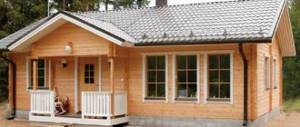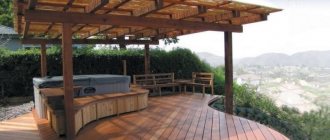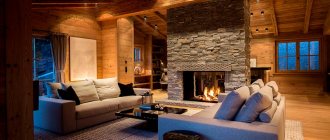What is the blind area of a building and its purpose?
The blind area is the area around the building, which is covered by a waterproof layer inclined outward from the base of the house along which a drainage system is installed. Its main purpose:
- protect the foundation and the foundation underneath from soaking in rain and melt water from the ground surface;
- divert water from the perimeter of the foundation and discharge it into a sewer or drainage ditch;
- improve the area around the house or even decorate it;
- protect the foundation of the building from large roots of plants - trees and tall shrubs.
In the case of different types of pile and columnar foundations, when there is no basement under the first floor of the house, protection can promote ventilation of the subfloor, draining rainwater from the projection of your house to at least its width.
What is a blind area and why is it needed?
The strip built around the house is called a blind area. It consists of underground and aboveground layers.
This design prevents damage to the base from the influence of precipitation, as well as from the influence of groundwater. Proper construction of a path around the house will allow:
- Prevent heaving of the soil from becoming saturated with moisture and freezing. This phenomenon will lead to unwanted movement, which will cause the foundation to crack and the entire house to collapse.
- Correctly distribute the load that acts on the base, which will also protect it from cracking.
- Prevent moisture from getting into the basement, which is especially dangerous if there is a basement, as mold and mildew begin to develop and the general atmosphere in the house worsens, and this can also provoke respiratory diseases.
- Get extra space to move around the house, and if designed correctly, it’s also an excellent decorative element.
In order for the listed functions to be performed at the proper level, it is important to strictly follow the execution technology, which will depend on the type of design chosen.
Basic rules for building a blind area of a house
The construction of a blind area for strip and monolithic-slab foundations begins after work on the vertical external waterproofing of its walls. Read how this work should be carried out here (link) or here (link).
The cavity or space between the soil, untouched when the pit for the house or the trench under the tape was torn out, and the foundation itself is filled with soil. This operation is called backfilling. In this case, the layer directly next to the wall can be covered with clay and compacted. Place the clay layer just below the ground level, for example, 100 - 150 mm. The “thickness”, or rather the width of the clay castle at the level of the base of the base, should be at least 250 - 300 mm. As backfilling progresses, this width can increase to 400 - 500 mm. Further from the walls there may be ordinary soil.
All backfill must be compacted layer by layer. Around the entire house you need to leave an unfilled “ditch” up to 150 - 250 mm deep. Coarse sand or screenings with a slope of at least 1.5 - 2%, i.e. at least 20 mm/m, are poured into the groove as a sublayer, which are leveled and compacted. The thickness of the sublayer is 50 – 80 mm.
There should be no rigid connection between the monolith of the blind area and the wall of the foundation or plinth. Very often, especially in loose soils, a monolithic blind area can move relative to the base. In this case, the waterproofing layer of the base and plinth may be destroyed, and during rains or in the spring when the snow melts, it will become damp.
To prevent this, when concreting the formwork, you need to lay two or three layers of waterproof material between the waterproofing and the end of the protective layer. You can use two strips of roofing felt or thick polyethylene, laying them on compacted sand or screenings, lifting them along the wall and securing the top edge.
If the waterproofing layer is extended under the entire formwork and brought into the drainage groove, then you can use materials that allow water to pass through - a layer of crushed stone, pebbles, paving slabs, paving stones, etc.
After this, a layer of concrete is laid at least 50, and preferably 70 - 100 mm. When concreting, it is advisable to use a mesh of reinforcement with a rod diameter of 3-5 mm and cells of 100 x 100 or 150 x 150 mm.
After about 4 - 6 meters, an expansion joint is made so that the concrete does not burst in the cold in winter or bulge in the heat in summer. In the expansion joint area, it is worth laying two layers of waterproofing on the bedding - roofing felt or thick polyethylene with a width of 700 - 1,000 mm. Fill it with bitumen mastic, sealant or even sand.
A drainage groove is made along the outer edge of the layer below its surface to drain stormwater. This can be a groove in the ground, in the form of a concrete strip or made of concrete blocks.
This is how the correct foundation blind area is made.
If you have the necessary tools and skills in using them, then by purchasing the necessary materials, you can make the foundation blind area with your own hands.
High-quality blind area with your own hands
If you have some construction experience, it is quite acceptable to make a blind area around the house with your own hands, which will require the following tools and building materials:
shovel;
- construction trowel;
- reinforcing mesh;
- roofing felt (or other material for waterproofing);
- boards;
- slats;
- sand;
- crushed stone
- clay;
- chemicals (herbicides).
Before starting work, it is necessary to carefully mark the area. The top layer of soil is removed along the entire perimeter of the upcoming work. If you plan to build a structure made of concrete, the depth of soil removal should be at least 25 cm. The soil should first be treated with herbicides to prevent plant growth in the future.
Then it is necessary to erect formwork from boards, and lay clay on pre-compacted soil. A layer of sand is placed on the clay (about 10 cm is enough). The sand must be thoroughly compacted. It is advisable to do this using water to make the layer denser. About 7 cm of crushed stone is laid on the resulting pillow. A reinforcing mesh is placed on top. It will allow the structure to withstand high loads, both in tension and compression.
In the place where the foundation blind area will have points of contact with the base, it is imperative to make an expansion joint. Its presence is mandatory, since it allows you to successfully avoid deformation of the base in the event that the structure being built shrinks. The width of the expansion joint should vary from 1 to 1.5 cm. In this case, the joint itself is filled with mastic, bitumen or roofing felt in several layers. The blind area is poured with concrete, carefully leveling the surface.
Concrete must be periodically moistened with water, not allowing it to dry out until it has completely hardened.
Blind area of strip and monolithic foundations
Do you need a blind area for a strip foundation? Yes, it is necessary, and first of all because the reinforced concrete strip is completely in the ground. You can read how to arrange a strip base here.
It is made from the outer perimeter of the building to a width that is 400 - 800 mm greater than the overhang of the roof of the building.
The roof overhang is the vertical projection of the outer edge of the roof onto the ground. That is, water dripping from the roof should not fall on the ground, but on the concrete.
The top of the concrete can be decorated with stones, such as pebbles. It is pressed into fresh concrete mortar so that only the rounded side of the stone protrudes.
You can also decorate with paving slabs, which are laid on top of a layer of concrete of lesser thickness on a thin sand or cement-sand layer.
</>
Instead of paving slabs, you can use granite, gabbro-basalt or artificial stone paving stones.
Important nuances of technology
For those who doubt whether the tiled blind area will fully fulfill all the functional requirements assigned to it, let us say that even despite the presence of a large number of joints between the tiles, such a blind area, if it is made according to all the rules of technology, will be no less reliable and effective and more durable than conventional concrete blind areas.
There are three basic rules that must be taken into account when building a blind area:
- 1. Minimum width;
The SNiP requirements do not stipulate the minimum width of the blind area around the house, but experienced builders agree that it should be more than one meter. Practice shows that a blind area less than one meter wide is operationally inconvenient, since when walking along it, a person of average build will touch the walls of the house with their shoulders.
| Expert advice ! In order for all the liquid pouring out from the pipes of the storm drainage system to be removed to a safe distance from the foundation, and not absorbed into the ground immediately near the walls, the width of the blind area should be thirty centimeters greater than the width of the roof overhang. |
- 2. Solidity;
The blind area should be monolithic along the entire contour of the walls of the house; it should not be interrupted at the corners of the building, since in this case the effectiveness of protecting the foundation from surface water will be greatly reduced.
- 3. Slope.
The liquid that enters the blind area from the storm drainage pipes must drain from it by gravity. To do this, during construction it is necessary to make a slope of 2-2.5 cm from the point of contact with the wall to the outer contour.
Figure 1.5 : Correct slope of the blind area
See also
Foundation shrinkage
Foundation piping
Drilling for the foundation
Blind area of a pile reinforced foundation
If the pile foundation has a grillage buried in the ground or lying on the surface, then the blind area of the pile foundation is done in the same way as on a strip foundation.
If the grillage is raised, that is, when its lower part is located above ground level and the gap is not closed by a fence, then the question is whether a blind area is needed for a pile foundation? the answer is not so simple. First of all, it should be “placed” under the grillage and the inner edge should be raised with a roller having a height of at least 30–50 mm. But it is better and easier to lower a fence from the outer plane of the grillage, for example, from a sheet of flat slate. On the plane of a rectangular pile, the joint of the layer is made in the same way as with the wall.
Our services
We are based on services: pile driving, leader drilling, sheet piling, as well as static and dynamic testing of piles. We have our own fleet of drilling and piling equipment at our disposal and we are ready to deliver piles to the site with their further immersion at the construction site. Prices for driving piles are presented on the page: prices for driving piles. To order work on driving reinforced concrete piles, leave a request:
Soil testing
…
More details
Strengthening foundations
During the operation of buildings, there is often a need to strengthen old foundations that have lost a significant part of their load-bearing capacity, as well as during reconstruction...
More details
Strengthening the foundation of an old wooden house
We will talk about how work is carried out to strengthen the foundation of a wooden house. Our company, in order to avoid the need to strengthen the foundation in the future,…
More details
Useful materials
Foundation for a house made of foam blocks
Foam block is a universal building material that has gained wide popularity in recent years due to its reasonable price, light weight and minimal thermal conductivity.
Country houses on screw piles
Screw flocks are a pretty good option for building a foundation for a cozy country house.
Blind area of a pile-screw foundation
You have built a wooden house on a high pile-screw foundation. (How to do this is here). A natural question arises: is a blind area needed for a pile-screw foundation? After all, the pile is protected quite well by zinc and paint coating. The answer is the same as before - it is necessary.
How it is done can be seen from the figure.
They also start with a drainage ditch, into which a drainage pipe or open drainage blocks are laid. Then the fertile soil is removed right up to the pipes of the screw piles, a sand cushion is filled and compacted in the thickness of which a strip of rolled waterproofing must be laid, the inner edge of which is raised and fixed to the pipes. A concrete or tile layer is laid on the sand cushion.
Manufacturing of concrete blind area
The “ribbon” under the building is formed in wooden formwork or poured into a prepared pit, the walls of which are made of curb stone or clinker brick. In the second option, intermediate gaskets made of foam or thick rubber are used. Additional components are needed to form expansion joints. Removable formwork is assembled from lumber (plywood, edged boards, MDF sheets).
It will not be possible to form a monolithic concrete blind area in one go: you will have to order several machines with mortar and hire workers. They fill the “tape” themselves, dividing it into sections. Each sector is fenced with wooden boards 10 mm thick. The volume of each section should be approximately equal to the amount of concrete in one batch. The boards are pre-impregnated with used motor oil or bitumen. Wooden jumpers reduce the stress that occurs in the material when the outside temperature fluctuates.
Preparatory work
Before construction begins, a number of activities are carried out. Preparatory work:
- Marking. At a distance equal to the length of the canvas, markers are inserted into the ground. The latter are placed in the corners of the building, as well as in places where the position of the foundation changes. A string is tied to the markers, pulling it sequentially through each point. The rope will indicate the border of the “tape”.
- Excavation. Dig a ditch 25-30 cm deep; the fertile soil can be used to organize vegetable beds. The rest of the soil is transported off-site.
- Foundation cleaning. The surface of the concrete base is thoroughly cleaned of lumps of soil with a stream of water or hard brushes.
- Backfilling the sand cushion. The base of the ditch is leveled with a shovel, and the surface of the soil is compacted. Sand is poured in an even layer, moistened and compacted. Poorly compacted material will cause subsidence of the blind area, cracking and destruction.
- Backfilling of crushed stone. The latter is laid out on the bottom (size 10-30 mm).
For your information!
The sand cushion is made from sifted material. Large inclusions do not strengthen the layer, but on the contrary, during spring heaving of the soil, they destroy the canvas.
Arranging a “ribbon” of paving slabs
The canvas of individual elements is placed on a loose cushion - a prancing board. The latter is made from sand and cement. When dry, this composition will fill all the voids, and when wet, it will “seize” into a single layer. Gartsovka retains its shape well and is not washed out by water. The tiles are laid on the mixture sequentially, each of them is tapped with a rubber mallet. The gaps are filled with sand or grout.
The direction of laying the tiles is from the curb towards the base of the building. As you move, they form a slope along which water will flow during rain. The curb stone is placed below the surface of the tile, otherwise stagnant areas will form where liquid will accumulate. A gap is left between the canvas and the base of the building. It is necessary to ensure mutual movement of the foundation and the canvas. Displacement may occur due to different masses of the building and the tiles.
For a house on stilts
Buildings erected on soil with low bearing capacity are equipped with a pile foundation. A blind area is also made for such supports. The protective belt performs several functions:
- Prevents soil erosion around screw piles.
- Slows down the rate of metal corrosion.
- Prevents moisture from entering the lower floor of the house.
- Reduces soil heaving.
- Protects the subfloor from water penetration.
The design of the blind area resembles a wide path made around the perimeter of the building. It is made with an inclination of 4-6 °. The canvas consists of an outer decorative layer and an inner waterproofing pad. The latter is connected to the base of the house. Step-by-step plan for the construction of the canvas:
- They are digging a pit around the house.
- The soil at the bottom of the pit is compacted, a layer of clay is poured into it and covered with roofing felt or other roofing material.
- A second layer of sand or crushed stone is formed.
- Formwork is assembled from the outside of the canvas, dividing the blind area into equal sections.
- Concrete is poured to form the desired slope.
- The formwork is dismantled after the mixture has hardened, and the resulting gaps are filled with fine sand.
Insulation
Thermal insulation is necessary for “bands” constructed near buried foundations, and especially around the basement floor. Insulation allows you to maintain a positive temperature of the soil near the base of the building, which compensates for the extrusion force from frost heaving. Thermal insulation is not done only for pile-grillage or buried foundations.
For your information!
It makes no sense to make the thermal protection wider than the size of the fabric covering, which is needed for effective water drainage.
The blind area is insulated with extruded high-density polystyrene. This thermal insulation material does not absorb water (unlike polystyrene foam), it has high strength and resistance to external loads. The thickness depends on the climate in which the structure is located. In moderate conditions, with an average five-day temperature not exceeding 20 ° C, the insulation size is 30 mm, in colder conditions – 50 and above. Thermal insulation material is laid on a prepared sand cushion, otherwise due to subsidence of the earth, the slabs may become deformed or collapse.
Repair
Over time, the blind area undergoes erosion. If the covering is made of paving slabs, they are simply replaced with new ones. It is much more difficult to repair a monolithic concrete sheet. Repair options:
- Local cracks are filled with a mixture of cement and water.
- Medium damage expands. Bare reinforcement is cleaned of rust and treated with anti-corrosion compounds. Cracks are sealed with polymer materials or cement.
- Severe damage is restored by pouring a new canvas. At the same time, the curbs and reinforcing frame are changed.
Repair of the blind area
What to do if the blind area has moved away from the foundation?
The easiest way is to wait until spring and do repairs after the ground thaws.
The simplest repair is to seal the cracks with a cement-sand mortar of at least grade M 50 or M 100. If they crack again, you can, after clearing them down to durable concrete, fill them with polyurethane sealant, having previously pushed a strip of polyethylene foam into the crack. The top of the sealant must be covered with cement-sand mortar.
If cracks and crevices arise from the subsidence of uncompacted soil, then it is necessary to remove the bursting layers, add and compact the soil and lay the protective layer again.











